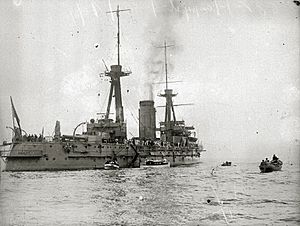Pact of Cartagena facts for kids
The Pact of Cartagena was an important agreement made on May 16, 1907. It happened in Cartagena, Spain, and involved three countries: France, Great Britain, and Spain. The main goal of this pact was for these countries to agree to keep things as they were in the western part of the Mediterranean Sea and the Atlantic Ocean. This especially included their islands and coastal areas.
This agreement helped Spain become closer to Britain and France. These two countries already had a friendly understanding called the entente cordiale. The pact was a way to stand together against Germany's growing influence, especially in Morocco. Both Spain and France had agreed to share influence in Morocco, and Britain supported this.
During the First World War, some Spanish politicians mentioned the Pact of Cartagena. They believed it showed that Spain should support the Entente powers (Britain and France). For example, on April 21, 1915, a leading Spanish politician named Antonio Maura said that Spain had a special position in North Africa and the western Mediterranean because of this agreement. He felt Spain had shared interests with England and France, and they had promised to work together to keep things stable.
What Happened After the Pact?
After the First Moroccan Crisis in 1906, Spain's connections with Britain and France became stronger. People in Spain also wanted the country to have a stronger military. Because of this, the Spanish government made a defense plan with Britain and France, which was the Cartagena Pact of 1907.
Here's how the plan worked:
- Britain and France would help defend Spain if needed.
- In return, Spain's navy would help the French Navy if there was a war with the Triple Alliance (which included Italy and Austria-Hungary).
- The Royal Navy (Britain's navy) needed to focus on the North Sea to face the Imperial German Navy.
- The French navy alone might not be strong enough against both the Italian and Austro-Hungarian navies.
- France also needed to move its soldiers from North Africa to Europe. Spain's help would be very important for this.
With help from the United Kingdom, Spain was able to build new warships. They built the España-class battleship. They also planned to build the Reina Victoria Eugenia-class battleship, but these plans were stopped when the First World War began.
Later, when the Great War started in 1914, the Italian government decided to stay neutral. Since the Pact of Cartagena was partly signed because of the threat from the Austro-Hungarian and Italian navies combined, Italy's neutrality gave Spain more freedom. Spain also decided to stay neutral throughout the war. Italy later joined the Entente powers.
See Also
 In Spanish: Acuerdos de Cartagena (1907) para niños
In Spanish: Acuerdos de Cartagena (1907) para niños
- International relations (1814–1919)
- Causes of World War I
- Diplomatic history of World War I
Sources



